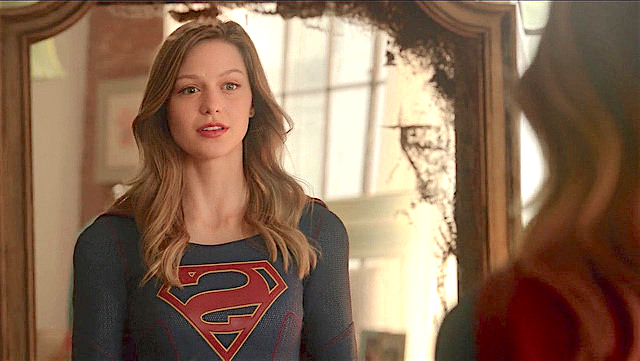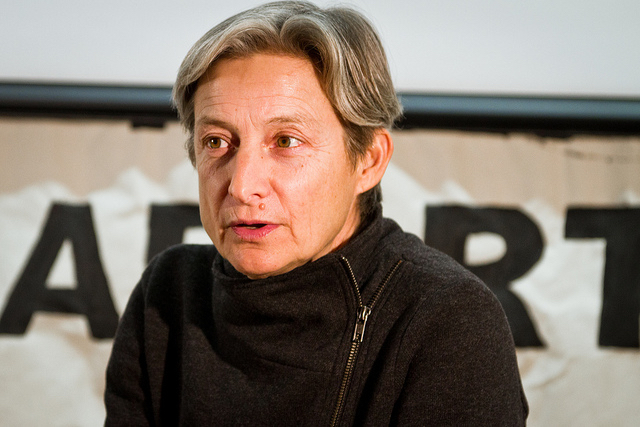It all started so innocently. On a Saturday afternoon at Comic-con, the cast of the popular CW Network show Supergirl was putting on a pretty standard session to recap their previous season and preview the upcoming one. This is the kind of thing that happens hourly, day after day, at Comic-con, a chance for dedicated fans to interact with stars (and often the showrunners) of their favorite shows. Generally, it’s a chance to feel the love.
And so it should have been for Supergirl. Having survived as a shift from CBS and the departure of Calista Flockhart (one of the two most recognizable names on the show), it had established itself as one of the most popular of the Greg Berlanti-run superhero titles on the CW network. It is a rarity among superhero shows, one centered on the exploits of a young woman.
Kara Zor-El, another refugee from the long exploded Krypton, is a millennial trying to find her way through the complexities of professional and social life, while also defending the citizens of National City from threats both terrestrial and alien. With the title character played by former Glee mainstay Melissa Benoist, Supergirl combined superhero action with explorations of the social and working lives of young women and the complexities of millennial feminism.
In its second season, the show had also featured the blossoming of a lesbian relationship between Kara’s sister, Alex Danvers (played by Chyler Leigh), and Detective Maggie Sawyer (Floriana Lima). Although the representation of same-sex relationships in popular media has grown more common, they are still very much the exception. Where they occur, they tend to draw passionate interest from people in LGBTQ+ communities, anxious to see their identities authentically reflected, rather than being mocked, marginalized, or erased as they all too often are in the modern media environment and in the broader reaches of the public sphere.
The relationship between Alex Danvers and Maggie Sawyer had been handled in a subtle and sensitive way, particularly the process of Alex Danvers coming out as gay, and the second season of Supergirl had culminated with, among other things, Alex proposing marriage. This, combined with Melissa Benoist’s open and unapologetic feminism, seemed to cement the show’s popularity with a passionate fan base that skewed strongly young, female, and (to a greater extent than most shows) LGBTQ+.
https://www.youtube.com/watch?v=DaI6dcoRRQQ
But trouble was brewing. It was announced in May that Floriana Lima would not be a season regular. While not blowing up the relationship between Sawyer and Danvers (or actually killing one of them off), this was a matter of consternation to LGBTQ+ fans of the show. Adding to the general disquiet was the relationship, begun in Season 2 and seemingly doomed to continue in Season 3, between Kara and Mon-El (played by Chris Wood). While there are some among the show’s fans that approved of this pairing, many others looked askance. Mon-El is a pretty typical fixer-upper boyfriend. In the course of a season’s worth of relationship he had been dense, dishonest, dismissive, and patronizing. Many fans wondered why a character meant to be a role model for young women should be saddled with such a toxic stooge (with the question of why she needed a boyfriend at all left as an open question).
Dissatisfaction with Mon-El had led some fans to speculate on the possibility (and desirability) of a relationship between Kara and Lena Luthor. Played by Katie McGrath, Lena Luthor is the head of Lexcorp, the corporate entity formerly run by her brother (and traditional Superman antagonist) Lex Luthor, as well as being the closest thing that Kara has to a (non-family) female friend. Some have read the friendship between Kara and Lena as portending something more, not least because Katie McGrath has, from time to time (and by her account completely unintentionally) seemed to look at Kara in ways that suggested more than merely platonic friendship. Still, there had been no overt suggestion that this was in the cards and, to a great extent, it was driven by dissatisfaction with the Kara – Mon-El relationship.
It is common these days for fans to develop fierce commitments to relationships portrayed in their favorite shows. This is often referred to as “shipping” and it spills out across various social media platforms (most prominently Tumblr and Twitter) with a passionate intensity that can be quite startling. Particular ships are designated with nicknames so that those who are interested can follow via hashtags. In the case of the Supergirl, those who shipped Kara and Mon-El use #karamel while those who favor Kara and Lena Luthor use #supercorp (those focused on the relationship between Alex Danvers and Maggie Sawyer designate their ship #sanvers). One of the central features of Supergirl fandom had been the conflict between the #karamel and #supercorp shippers. Yet even with the extensive debates on Tumblr, and the worries of the #sanvers people about the future of their ship, the fan community was mostly functioning in the way that the people running the show and their corporate sponsors would have hoped.
And then came Comic-con. The cast had, for some reason, decided to do a sort of musical number as their recap of the previous season. Several cast members (in particular Jeremy Jordan) decided to take this opportunity to stress that the relationship between Kara and Lena was not going happen. The only person on the stage who really seemed to get what unfortunate territory had been blundered into was Katie McGrath, who at one point notes,
“The great thing about what we do is, like any art, anybody can read into it what they want and take from it, so you can see anything and take from it what you like. And that’s what’s great about this show. There are so many different ways to see everything. And if that’s what you see in it, you know, take it away.”
Sadly, her more sympathetic voice was drowned out by the collective insensitivity of her castmates. A video of the whole affair can be seen in The Mary Sue’s wrap up of the event, along with some of the outraged commentary on Twitter that followed. The events at Comic-con galvanized the #supercorp shippers. Jeremy Jordan, viewed as the main offender in the affair, had his Twitter feed deluged with angry posts. His response was to claim that he too was being victimized (by people’s anger), which predictably only stoked the fires. Other cast members maintained a judicious silence, yet their Twitter feeds (especially Melissa Benoist’s) have been filled with angry messages, and at the time of writing it seems that this is likely to continue until the cast as a whole (and perhaps the show’s runners as well) address the issue properly and publicly.
Supergirl Fans Are Rightfully Angry With the Cast’s Flippant Dismissal of Kara/Lena Luthor Shippers
To understand the response that this incident prompted, it is necessary to step back for a moment and look at some aspects of modern media culture. These can be cast in relief by looking at the fan culture of another currently airing show: Syfy’s Wynonna Earp. Based on a relatively obscure comic by Beau Smith, Wynonna Earp also features a strong young woman as its central character. There is a prominent same-sex relationship between Wynonna Earp’s sister Waverly and Deputy Sheriff Nicole Haught (designated in the shipping culture as #wayhaught) and LGBTQ+ people are not just prominent; they are dominant in the show’s fan base.
Yet, although there are important similarities between the two shows, the differences are perhaps even more significant. The show is run and predominantly written by a woman, former Lost Girl showrunner Emily Andras, and her influence on the tone and texture of the show is evident in myriad ways. Wynonna is allowed to be fallible in ways that young women in popular culture generally are not. She has para-romantic interests with the show’s two main male characters, Deputy Marshall Dolls and Doc Holliday, but Andras signally avoids the extremely overused love triangle trope, allowing their relationships to be complex and fluid and based on overt choice rather than implied obligation. Further, about two-thirds of the way through the first season, Andras made clear none of the main characters would be killed off in the finale, implicitly signaling to her audience, that there would be none of the “bury your gays” variety of events that have blighted so many shows recently (and about which more below).
The fan cultures differ in important ways as well. #Earpers (as the show’s fans designate themselves) tend to be a bit older. This, combined with the skill and sensitivity of Andras’ writing, goes a long way to explaining the fact that although there are Dolls shippers and Doc shippers (#TeamDolls and #TeamDoc respectively) relations between the two groups are quite cordial. Although the base itself is rather narrower than that for many of Syfy’s other titles, its niche penetration is much more intensive. In addition to extensive Twitter and Tumblr communities, Earpers organize real world meetups (especially at various cons) as well as online (and in-person) viewing parties. T-shirts and other fan gear are produced in quantities and varieties that far outstrip those for the two more traditional science fiction shows (Killjoys and Dark Matter) with which Wynonna Earp has been scheduled, even though the former have roughly twice the level of viewership as tracked by the ratings numbers.
While no individual element of this is unique, the whole evinces as high a degree of fan engagement as one can find in small screen media these days. As such, it puts the show at the forefront of a new strategic direction in small screen media that sees the achievement of higher levels of granularity rather than the casting of wider nets as measured by viewing statistics. The outlines of the strategy were described by Syfy executive vice president Michael Engleman in an interview with Marketing News in 2013 . Describing the marketing campaign for Sharknado 2, Engleman said,
“Creating interesting, sharable and scalable conversations with the right folks requires a balance of art and science, and a healthy mix of good, old-fashioned social skills—tone and manner—and smart social media analytics. It boils down to this: Be interesting to the people who are predisposed to be interested. And enable participation. We try to give our fans the platforms and tools they need to engage with our brand as deeply as they choose.”
Syfy’s current tag line, “It’s A Fan Thing,” could stand as a motto for the marketing strategy of Wynonna Earp. Somewhat coincidentally, its cast session was in the next band after that of Supergirl, and it was at that point that it was announced that the show had been renewed for a third season. This announcement had been awaited with some anxiety by the show’s fans because, as mentioned above, its numbers are significantly below those of Killjoys and Dark Matter, and not even in the same zip code of those of the Berlanti-run shows like Supergirl, The Flash, Arrow, and Legends of Tomorrow. Although it had (and has) an extremely avid fan base, one whose relative weight seems greater because of its extensive presence on social media, the actual viewer numbers are, if anything, down slightly from the first season. Yet Syfy was willing to renew the show on the basis of those numbers even before the current season had ended.
The focus on intensive niche engagement rather than extensive promotion is a defining feature of a small screen media landscape that has changed dramatically in the last decade. The days when people would sit down at a certain nationally designated to time to watch a particular show, or when the expression of the success of a show would be people getting together in bars to watch Cheers or Melrose Place in real time are over. The fact that there are currently real time viewing collectivities (mostly online and facilitated by live tweeting by showrunners and cast) deflects from a deeper pattern of recording, bingeing, and rewatching that is now the dominant mode of consumption. That fact that the common moments still happen is a symptom of successful engagement, not a precursor for it.
Syfy is by no means alone in adopting this approach. Another excellent example is, ironically, the Hallmark Channel. In the past one might have associated Hallmark with an older demographic, allergic to technology and wanting only an atavistic return to a sort of Norman Rockwell world that exists only in their memory. But the next work has fully embraced the power of social media to penetrate its existing fan base with greater intensity. Using Twitter as a means of bringing viewers together to talk about its extremely extensive slate of movies (roughly 60 in any given year), Hallmark has positioned itself in such a way that it is now possible to see When Calls the Heart trending competitively on Sunday nights against a nationally much more popular show like AMC’s The Walking Dead.
The importance of social media to the new media environment as a whole has important implications for the ways that LGBTQ+ communities interact with it. Social media play an important role in allowing socially marginalized groups to communicate, to form robust networks, and to engage in identity formation outside, or in the interstices, of the hegemonic culture. LGBTQ+ communities are particularly (and justly) sensitive about their representation in media. Although it is now more frequently the case that LGBTQ+ people see themselves positively reflected in mass media, it is also the case that they stand a disproportionately high chance of seeing people like themselves getting killed (often violently). The “bury your gays” trope is easily identifiable and demonstrable and constitutes a new and disturbing mode of erasure. Rather than simply not appearing, LGBTQ+ people (and in particular lesbians) are now prone to be dispatched, often precisely in the moment of realizing satisfaction or happiness.
This has continued to happen with disturbing frequency and is especially acute in cases where the runners of shows have seemed actively to court their LGBTQ+ fans. In roughly the last year, lesbian characters have been killed off in The 100, The Walking Dead, and Orange is the New Black, and Person of Interest, to name only the most prominent instances.
Clearly, the actions of the Supergirl cast are of a different kind. But the resulting furor has to be seen in this context. Having been presented with the opportunity to see themselves reflected, and having been courted by media entities and showrunners purporting to be their allies, there is a pronounced and justified feeling among LGBTQ+ communities that turning the corner has to mean really turning the corner. The 100 showrunner Jason Rothenberg tried to deflect criticism of a particularly heinous instance of “bury your gays” by claiming that it was a matter of artistic license. But showrunners and writers don’t work in a vacuum. The era of social media is one of increased mutual influence between creators and consumers, in which failure to proactively recognize how creative products will be read and received constitutes a major failing.
The ongoing controversy surrounding the actions of the Supergirl cast members is another outgrowth of this new environment. With the exception of Katie McGrath, the show’s cast seems to have failed to understand the ways that what they create fits into the individual and collective imaginaries of those who consume it. It may be the case that the #supercorp shippers are tilting at windmills. But the correct response to this is either silence or support, not mockery. We are living in a moment in which mass media, much (and mostly justly) maligned over the course of the 20th century, has an increased capacity to combat the marginalization of LGBTQ+ communities (and others as well), but only if the creators have the sensitivity and critical faculties necessary to read the aesthetics and politics of reception and to conduct themselves accordingly.
https://www.youtube.com/watch?v=siDUteh0Tis
Photograph courtesy of Eyes on Fire. Published under a Creative Commons license.





